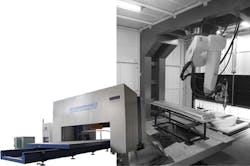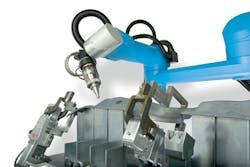Flexible multi-robot cutting production in an on-line solution
JOE ZENG
Both laser technology and robot trajectory-controlling technology are evolving rapidly, with 3D laser cutting robotic solutions becoming increasingly popular in the automotive industry. Extending its technological innovativeness, flexibility, and relative inexpensiveness compared to imported five-axis laser cutting machines, a 3D laser robotic cutting solution is accepted and appreciated by an increasing number of Chinese automobile manufacturers.
A wide variety of 3D laser cutting robotic solutions is available from a single-robot cutting platform on a flexible manufacturing line. Mainly, it involves two types of workpieces. One is a 3D car body structure and covering parts, formed by stamping or drawing, which includes a thermoformed piece. Another is the tubular metal structure, such as exhaust pipes and cross-members. The traditional way of body part production is stamping, followed by punching and trimming.
Thermoformed piece and tubular metal structures can be made by a five-axis laser cutting machine, which is so expensive that it only can be afforded by joint ventures.
The 3D laser cutting robotic solution has not been widely accepted yet because of many factors. Based on market changes of supply and demand, this article discusses the development and prospects for the robotic 3D metal-cutting laser solutions.
New businesses in the automotive industry
Under new industry situations, the supply chain should be able to readily adapt to changes for the diversification and individuation of demand. The millions of single-vehicle types that have been sold in China will become history because in a competitive global market, each company has to quickly react to changes in its production requirements in an ever-changing competitive landscape. A large number of new car types is the beginning of changes for the automotive industry and the theme for new vehicles acceptance in the market is unquestionably new—new and different. Considering their low cost and flexibility, 3D laser cutting robotic solutions are rapidly emerging as the preferred choice for many laser cutting or machining applications, from automotive spare parts to the engineering machinery industry, passenger car bodies, farm vehicles, and electric cars. After confirming low risk and efficiency, customers now use robotics solutions to replace conventional mold making and punching in larger batches.
Conventional robotic laser cutting
Robotics are widely used in the automotive industry for various applications, but have not been accepted for laser cutting due to three reasons. First, robotics in the automotive industry focus on applications that require low precision, such as spot welding, arc welding, painting, and handling, while accuracy is not adaptable for automotive laser cutting—especially accuracy in producing small, round circles. For example, the requirements of cutting small, round circles with a 5mm diameter cannot be achieved by ordinary robots; even a circle 10mm in diameter would be cut into an ellipse. Another reason is efficiency: ordinary robots with poor axis control capability or overloaded axes are not suited for fast-moving targets. Finally, lightweight robots are not sufficiently rigid, leading to tremble and faint tracking features. In addition, the severe deformation of robots cannot ensure the precision of laser cutting. For these three reasons, robotic solutions—popular in conventional automotive industry applications—are being questioned as a laser cutting method.
Solution supplier
The Stäubli group, known worldwide for over a century because of the quality of its methods and processes, has expanded its mechanical engineering know-how and its technological innovativeness to robotics. So, Stäubli robots have their own special gear box design instead of buying traditional reduction gear boxes like a normal industry robots supplier does, and this is the key reason to make Stäubli robots precise in laser cutting applications.
Meanwhile, the Stäubli robot is equipped with a high-quality, cast-iron tube construction, guaranteeing its high rigidity. It uses aviation aluminum, which has lower weight and is hard to transform. Therefore, these special robots match laser cutting process needs in automotive.
Quality depends on integrator's experience
High efficiency is one of the most important reasons for five-axis laser cutting machine center growth in the automotive industry. We suggest that laser cutting quality is determined by the quality of system solution and integrators' experience involved in the complex laser cutting process. Some system integrators choose ordinary robots that are not suitable for laser cutting, which brings little effect and low efficiency, leading to the user's sales resistance. First-class integrators integrate robots with high precision into exquisite systems. The laser cutting systems range from basic units to a variety of flexible units based on various products, such as single, double, and more robots fixed with platforms.
Han's Laser Company is a highly regarded Chinese laser system integrator, and FIGURE 1 shows their RX160L ceiling frame with moving table, which looks like a five-axis CNC machine. This company has experience with CNC machines so they can integrate a very rigid and precise mechanical structure and use the RX160L robot in large working range without the need for an extension axis in the cutting direction. So, this solution is very precise and very fast for laser cutting in automotive. For example, a Han's customer, a well-known Chinese passenger car manufacturer, has purchased more than 15 robotic laser cutting systems instead of five-axis machines, but the system price is about one-quarter that of international competitors.
Robot laser cutting of metals and plastics is often related with poor performance. This is due to the fact that most robot laser cutting system integrators do not have sufficient experience with the cutting process and robot motion control research. So, some of their customers see low-level cutting results such as low speed and lack of accuracy regarding the required specifications. As a conclusion, these customers make their decision that a robot cutting system is not suitable for automotive and that the 5-axis CNC machine still is the best choice.
We know this is not true. Staubli’s partner, Jenoptik, uses a customized TX90XL robot for CO2 and fiber laser cutting in automotive applications. The picture shows a B-pillar being cut and due to the basic accuracies of Staubli, the customized JENOPTIK robot cutting system is able to reach accuracies for locating holes down to ±50μm and speeds >200mm/s for straight cuts. Only this special robot setup can maintain the high accuracies of a standard robot due to their Beam-In-Motion (BIM) technology and low-weight cutting head, which provide the accuracies and cutting speeds that a gantry cutting machine can reach.
FIGURE 2 shows the Jenoptik custom-developed laser cutting system for thermoforming high-strength steel, which has been successfully used on the Volkswagen Polo.
With the combined efforts of the robot company Stäubli and system integrators, the robotic laser cutting system will become more popular in the Chinese automobile market.
JOE ZENG([email protected]) is the national sales manager at Stäubli Hangzhou Ltd., Hangzhou, China.

